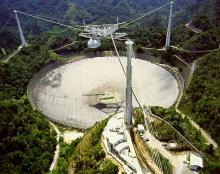Listen to the Arecibo Observatory on HF
Listen to the Arecibo Observatory on HF

By Dr. Chris Fallen, KL3WX
Geophysical Institute - University of Alaska, Fairbanks
The Arecibo ionospheric HF heating facility will be operational for a research campaign from 24 to 31 July 2017. Because the facility transmits on the HF frequencies 5.125 and 8.175 MHz, it is possible that its signals can be heard world-wide. QSL cards are available for interested SWL. The new Arecibo ionosphere HF heater nominally transmits 600 kilowatts net power (100 to 200 megawatts effective radiated power) and has a unique Cassegrain dual-array antenna design that increases the gain of three crossed dipoles for each band using the signature 1000 ft spherical dish reflector.
During the upcoming campaign, the Arecibo HF transmitter is limited to two frequencies, 5.125 and 8.175 MHz. Campaign HF transmissions will start at approximately 1600 hours UTC on 24 July 2017 and be active approximately 24 hours per day, with some occasional downtime for maintenance and other activities lasting one or more hours. Generally, the 8.175 MHz transmissions will occur in the daytime when foF2 is expected to exceed that value, between approximately 1830 and 2230 hours UTC. Otherwise the HF transmissions will occur at 5.125 MHz. The Arecibo incoherent scatter radar (ISR) will also be active throughout most of the campaign, but since it operates in the UHF band at 430 MHz long distance propagation is not expected.
These transmissions will be in the vertical direction so this is an excellent opportunity to observe NVIS from a powerful transmitter in Puerto Rico. Dr. Chris Fallen, KL3WX, will be conducting an experiment using O-mode polarized CW for measuring plasma wave and turbulence effects. Experiments by other scientists may use X-mode polarization. To the best of Chris's knowledge, all experiments will be CW with no amplitude or frequency modulation.
SWL QSL cards are available by sending an SASE to W3HNK, the QSL manager for KP4AO, the Arecibo Amateur Radio Club. Special thanks to Angel, WP3R, the president and trustee of KP4AO and Arecibo Head of Telescope Operations and Spectrum Manager for the QSL information.
